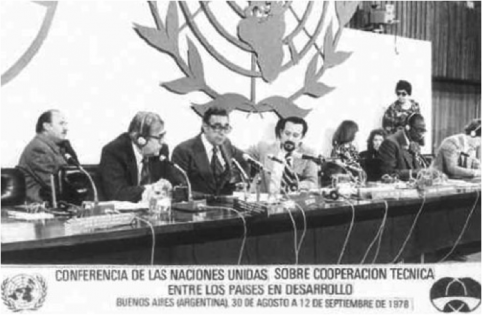
The guiding terms and principles of South-South Cooperation are distinct from that of other donors (UN Office for South South Cooperation, Objectives & Benefits of SSC)
Somewhere between 1.5 and 25 billion dollars: these are scholars’ current estimates of how much development finance China provides each year to other countries. That margin of error is 30% larger than the total aid from the United Kingdom in 2013, the second largest donor in the world.
We’re increasingly aware of the important role that countries in the global South, including China, play in development cooperation. But as long as we remain dependent on existing definitions for measuring development cooperation – specifically the Organization for Economic Cooperation and Development’s (OECD’s) definition of Official Development Assistance (ODA) – we won’t really understand how big this role is.
In the first post of our series, we discussed that some of the basic assumptions of the OECD’s definition of ODA are at odds with how Southern countries view development cooperation. For these reasons, many Southern countries are not willing to report their aid to OECD’s Creditor Reporting System (the main source of data on development assistance). Even for those that do report aid to the OECD, these definitional issues mean that the figures likely do not represent the universe of what these donors consider aid.
It’s time that we admit that this is a problem, and address it. To do so, we first have to understand the basic principles of South-South Cooperation (SSC).

Image from the 1978 Global South Conference on Technical Cooperation between Developing Countries in Buenos Aires (UN Office for SSC)
Understanding South-South Cooperation
South South Cooperation first took hold in the 1950s, as newly independent states sought to develop an alternative to the Bretton Woods system established after the Second World War. Countries across Asia and Africa asserted the importance of cooperation “on the basis of mutual interest and respect for national sovereignty.” The principles of SSC have provided an important framework for collaboration, including the Non-Aligned Movement and the Group of 77. Recent meetings affirmed that SSC for development must be based on, “respect for national sovereignty, national ownership and independence, equality, non-conditionality, non-interference in domestic affairs and mutual benefit.” Additionally, these meetings stressed the central role of technical assistance in SSC contributions to development, based on the 1978 Buenos Aires Plan of Action on Technical Cooperation among Developing Countries.
If taken one-by-one, we can see how the existing definition of ODA becomes problematic if the principles are accepted as they stand.:
Focus on Technical Cooperation
South South Cooperation providers assert that their first-hand experience with developmental and regional challenges make exchange of technical expertise and knowledge an essential part of development cooperation. However, assigning an actual monetary value to this kind of technical assistance can cause several problems. If we rely on the typical salary of a technical expert to determine the ‘value’ of technical cooperation, we assume that technical cooperation from Northern countries like the US is ‘worth’ more than cooperation from Southern countries, where wages are typically much lower. There is also controversy over whether technical assistance should be included in aid figures, as it does not represent a direct financial contribution to the recipient country. These issues create practical challenges and tensions with the principle that technical cooperation should be at the center of SSC.
Mutual Benefit
The basic premise of South South Cooperation is that Southern countries will develop together. Therefore, much SSC-based development cooperation takes the form of aid that promotes commercial interests in the providing country (whether indirectly as tied aid, or directly as aid to support exports or other commercial activities in the providing country). However, the Development Assistance Committee’s (DAC’s) definition of ODA is based on the premise that the donors’ commercial and poverty reduction interests should be separated. Any tied aid requirements must be reported, and official flows that primarily promote commercial objectives, such as export support, are excluded from ODA.
By excluding official flows with commercial intent, ODA would capture only a fraction of what most SSC providers consider aid. Furthermore, some SSC providers feel that adhering to DAC standards would undermine the principle of mutual benefit.
Sovereignty and Non-Interference
Placing a premium on respect for sovereignty and non-interference, South South Cooperation providers avoid setting conditions on aid. DAC donors, on the other hand, support conditioning aid on political reform to promote good governance. This represents a fundamental difference in aid philosophies: SSC providers oppose the ODA standards arguing that the standards do not sufficiently uphold the principles of sovereignty and non-interference.
Next Steps: (Re)Defining the Terms
It is important to acknowledge that individual South South Cooperation providers vary in their stances on the issues described in this post. China and India have taken a stronger stance against coordination with the OECD DAC’s aid reporting efforts. Latin American countries have actually developed their own, robust methodology for measuring development cooperation. Some Arab Gulf and Eastern European countries have engaged the OECD DAC in efforts to reform ODA reporting standards and currently report some of their aid to the OECD. These distinctions should not be glossed over: understanding them is a critical step in developing a new framework for development cooperation that engages actors across the global North and South.
We will take a closer look at issues unique to different donor groups over the coming weeks, including BRICS countries, Gulf Cooperation Council (GCC) countries, Latin American countries, and Central and Eastern European Countries.

